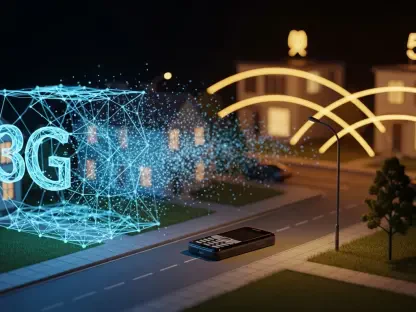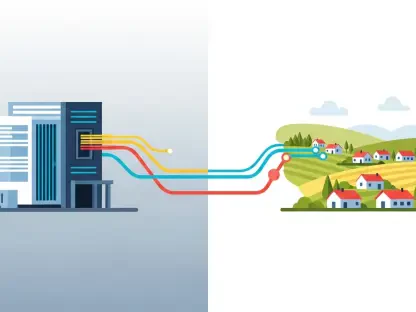EE, a UK-based mobile network operator, is on a mission to dramatically expand its 5G network coverage across the nation by 2028. This ambitious plan aims to cater to the increasing demand for high-speed mobile connectivity, crucial for both urban innovation and rural inclusivity. Experts across the telecommunications sector have varied opinions regarding the implications and strategies involved in EE’s plan. This roundup aims to compile these diverse insights, offering a comprehensive understanding of EE’s 5G network expansion.
The Rise of 5G: Setting the Scene for EE’s Ambitious Journey
Industry leaders understand the transformative potential of 5G technology. They emphasize its capacity to revolutionize industries, from enhancing IoT innovations to enabling cutting-edge AI-driven services. As EE commits to expanding its network, the stakes are high, underscoring the necessity of robust planning, comprehensive infrastructure strategies, and inclusive coverage.
Analysts argue that the rapid escalation of digital services and mobile applications intensifies the importance of a reliable 5G network. With consumers and enterprises pushing for uninterrupted connectivity, EE’s expansion could serve as a benchmark for future global telecommunications projects.
The Critical Role of 5G: Why Network Expansion Matters
There is a consensus that 5G represents a quantum leap in connectivity standards, with rapid data speeds and low-latency communications. Industry experts highlight its potential to facilitate new business models and drive economic growth, making EE’s role in expanding the network crucial.
However, some experts caution against focusing solely on urban areas, advocating for a balanced approach that includes rural and underserved regions. EE’s strategy could redefine regional connectivity, creating new opportunities and reducing existing digital divides.
Navigating EE’s Coverage Goals in the UK
With an eye on nationwide coverage by 2028, EE faces a complex landscape of technological and logistical challenges. Experts commend the company’s collaboration with Ontix, noting the innovative deployment of small cells across Westminster as a model of urban transformation.
Critics point out that while strategic partnerships are vital, maintaining aesthetic and cultural integrity requires nuanced planning and execution. Successfully integrating advanced technology into historical and rural landscapes remains a formidable challenge.
Westminster as a Flagship: Small Cells Transforming Connectivity
EE’s deployment of 80 small cells in Westminster showcases small cell technology’s transformative potential, providing seamless coverage while minimizing visual impact. Some urban planners view this as an exemplary case of balancing growth and maintaining the city’s historical charm.
Nonetheless, there is concern about scalability, with some questioning if such models can be replicated across different urban environments with varied regulatory hurdles. EE’s innovative strategy in Westminster could be a prototype for broader applications, spurring similar future initiatives.
Strategic Partnerships: Ontix and EE’s Collaborative Success
Experts acknowledge the successful collaboration between EE and Ontix in deploying small cells, leveraging existing infrastructure to boost network capabilities. This partnership combines cutting-edge technology with practical execution, offering lessons in effective network expansion.
While some emphasize the potential for more partnerships in accelerating technology integration, others advocate for a cautious approach, noting the potential complexities in aligning diverse organizational goals and maintaining seamless operations.
Visual Harmony vs. Technological Growth: Striking the Balance
Maintaining visual harmony while enhancing network capabilities is a significant task, as described by architectural and planning observers. The subtle integration of technology into existing structures, like lampposts and kiosks, represents a valuable lesson in technological aesthetics.
Although hailed as successful, some experts warn that prioritizing aesthetics should not overshadow the urgent need for infrastructure development. Maintaining a balance requires ongoing dialogue between engineers, planners, and environmentalists to achieve true harmony.
Bridging Urban and Rural Divides: Extending 5G Beyond Cities
EE’s focus goes beyond urban regions, recognizing the need to extend high-speed connectivity to rural communities. Experts agree that existing 4G networks provide a strong foundation for this endeavor, potentially transforming rural economies with enhanced digital access.
Addressing rural expansion challenges remains crucial. The rugged terrain and infrastructural limitations present unique obstacles, requiring innovative solutions such as satellite technologies and community-led initiatives, which are crucial for effective implementation.
Widespread 4G Base: Leveraging Existing Networks for Growth
Industry observers praise EE’s strategic use of its established 4G network as a stepping stone toward broader 5G coverage. By leveraging mature infrastructure, EE can efficiently scale 5G deployments, ensuring a smoother transition and more reliable service.
Nevertheless, some caution against over-reliance on 4G infrastructure, suggesting comprehensive upgrades to accommodate the demands of 5G. Addressing spectrum availability and regulatory alignment remains a priority for seamless network evolution.
Barrier Breakers: Challenges in Rural Connectivity and Expansion
Experts note that extending coverage to rural areas involves overcoming significant barriers, including high costs and logistical complexities. Prioritizing partnerships with local communities and using advanced technologies such as satellite links could mitigate these challenges.
Implementing fiber-optic backhaul and sustainable energy solutions are also critical for rural expansion. Practical innovations in infrastructure and a community-focused approach are essential for bridging connectivity gaps and ensuring sustainable growth.
Small Cells in Focus: Powering the Network Densification Strategy
Small cell deployment stands as a pivotal element in EE’s network strategy, helping offload macro network capacity and improving service in densely populated areas. Technologists highlight small cells’ role in enhancing connectivity and supporting tech growth.
Decision-makers remain cautious, emphasizing the need for strategic siting and efficient management to maximize benefits. Small cells are heralded as a vital solution, with their deployment requiring precise planning to achieve optimal network performance and capacity.
Urban Integration: From Lampposts to BT Kiosks
Urban integration experts commend EE for using existing structures like lampposts and kiosks, demonstrating an effective approach to network densification. This strategy minimizes disruption and aligns with smart city innovations.
Challenges remain, with considerations such as regulatory compliance and public perception. Collaborating with municipalities to streamline processes and engage communities will be vital for future urban network projects.
Evaluating Innovations: The Cutting Edge of Urban Network Solutions
Telecommunications analysts recognize EE’s role in pioneering urban solutions that blend innovation with practical application. Evaluating new technologies like network slicing and dynamic spectrum sharing highlights ongoing advancements pushing connectivity frontiers.
Despite successes, EE’s long-term effectiveness will hinge on its ability to adapt. Integrating AI-driven analytics and ensuring robust cybersecurity measures will be crucial as networks continue to evolve and expand.
Monetizing 5G: A Fresh Approach to Network Investment
Industry strategists view EE’s network monetization efforts as innovative, focusing on developing standalone (5G SA) networks for greater security and responsiveness. This strategy seeks to capture 5G’s full potential for both consumer and enterprise use.
Skepticism exists regarding profitability models, with discussions around pricing strategies, customer experience, and service differentiation. Aligning investment with market demands will be essential for sustaining long-term growth and profitability.
Inside BT Group’s Revamped Strategy: Standalone 5G Network Insights
The 5G SA network is widely acknowledged as a significant milestone in EE’s evolution. Delivering enhanced services like AI-driven capabilities and dedicated cloud experiences reflects an essential step in redefining connectivity standards.
Ensuring cross-platform compatibility and integration of emerging technologies remains challenging. Addressing these issues through innovative solutions and strong stakeholder collaboration is necessary for network modernization success.
New Horizons: AI-driven Capabilities and Security in 5G
Security experts stress the importance of AI and machine learning in refining network strategies. These technologies are seen as pivotal in managing security and improving service delivery, offering an edge in a competitive industry.
While AI holds promise, some experts caution about data privacy concerns, emphasizing rigorous measures to safeguard user information. Balancing innovation with cybersecurity priorities is crucial to realizing AI’s benefits while managing associated risks.
Recommendations for Industry Leaders: Pathways to Success
Collating insights from various experts offers several strategic recommendations for industry leaders contemplating 5G expansion. Emphasizing collaborative partnerships, innovative infrastructure solutions, and effective regulatory navigation arises as key themes.
Technology integration should align with a broader vision of sustainable and inclusive connectivity, addressing both urban and rural needs. Continuous innovation paired with adaptive management strategies will pave the way for successful network deployments.
Harnessing 5G: Practical Applications for Enhanced Connectivity
Advancements in 5G technology promise significant enhancements across different sectors. Analysts foresee transformative impacts in healthcare, transportation, and entertainment, among others, as 5G facilitates new applications and services.
Businesses are encouraged to explore practical 5G applications, focusing on AI-driven analytics, IoT solutions, and immersive experiences. Addressing industry-specific challenges with tailored 5G capabilities can unlock new growth opportunities and improved operational efficiencies.
The Future of Connectivity: How EE is Shaping New Norms
EE’s ongoing 5G expansion represents a turning point in connectivity, reshaping societal norms and driving technological evolution. By setting new standards and innovating infrastructures, EE is poised to influence connectivity landscapes meaningfully.
Observers recognize the potential for 5G to redefine digital experiences, offering enhanced connectivity solutions that support evolving consumer and enterprise demands. Building resilient networks that anticipate future trends will be crucial in sustaining relevance and competitive edge.
A Call to Adapt: Keeping Pace with Rapid Technological Evolution
In conclusion, adapting to technological advancements in telecommunications has proven vital for stakeholders across industries. Embracing continuous growth and change remains imperative, emphasizing the need for agile strategies and forward-thinking leadership.
Investing in robust infrastructure and prioritizing customer-centric solutions were pivotal in navigating technological shifts successfully. By aligning investments with evolving technologies, organizations have secured their position as leaders at the forefront of innovation and connectivity.









